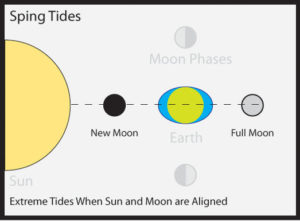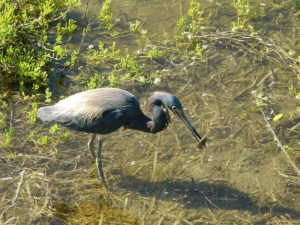The tides have a profound effect on Coastal habitats. The force of the water as it rises into (flood tide) and falls out of (ebb tide) the salt marsh and salt flats stirs up a great diversity of micro and macro organisms that in turn trigger a feeding frenzy up the food chain. Tides are created by the gravitational forces laid upon the earth by the Sun and Moon, but since the moon is the closest to Earth, it is the major factor in the intensity of the tides through its monthly lunar cycle. The most extreme tides with the largest range between high and low water are the “spring tides” and they occur just after a new and full moon. Spring tides occur twice a month and the term “spring” is not in reference to the season, but rather derived from the concept that the tides “spring forth”. During a new and full moon the Sun and the Moon come into alignment and their combined gravitational forces create a bigger bulge on the ocean and therefore a higher tide.


Just last week we had a full moon spring tide begin on Tuesday (7/19/16) and the flood tide came deep into the salt flats and left a greater part of it inundated for a good while. Here’s the view of the salt flats from the lookout tower.


A great variety of birds took advantage of this easy feeding opportunity and in turn the bird walk had some great looks at a greater diversity of birds on the salt flats. Waders, plovers, terns, gulls, and a few of the first shorebirds of the fall migration stopped by the flats for the buffet and delighted observers as they actively foraged for their food. In the photo below a Tricolored Heron has just caught breakfast!


Looking at some tide charts on the internet showed that the peak of the high tide was at 6:05am, with the water reaching 1.4 ft above mean sea level (AMSL) and it remained high well through the morning. Later in the afternoon it was obvious that the water was retreating as small currents cutting through the mud pulled the water back towards the bay. The ebb tide finally reached its lowest point of -0.6ft later on that night at 9:23pm. The spring tide lasted for the following three days making for a great week of birding and wildlife viewing at the SPIBNC salt flats! Experienced anglers understand that knowing how to read the tides could help them have a more productive fishing outing, but the same can apply to birding in coastal habitats.
Another factor that comes into play is location. While the high tide seems to be good for birding at the SPIBNC salt flats, the same might not be true in other spots. Some areas that are generally too deep for the birds could be more productive during the low tides when the water is shallower and more shoreline is exposed. Knowing how the tides affect different areas along the coast can help in determining when the best times to visit each site might be. For example, birding the SPIBNC salt flats from Bird Blinds #1 and #2 is best during the high tide, but birding just west of the mangrove line from Bird Blind #3 is best during the low tide when there’s more shoreline exposed. The next spring tide will come with the new moon in a few weeks on Tuesday August 2nd with the high tide peaking at 5:52am. There should be plenty of water left in the salt flats by the time the bird walk starts at 9:30am. We are looking forward to the fun! Join us! If you want to see what the month’s tides are going to look like, check out the tide chart on the last pages of our monthly Coastal Current magazine.
By: Javier Gonzalez




